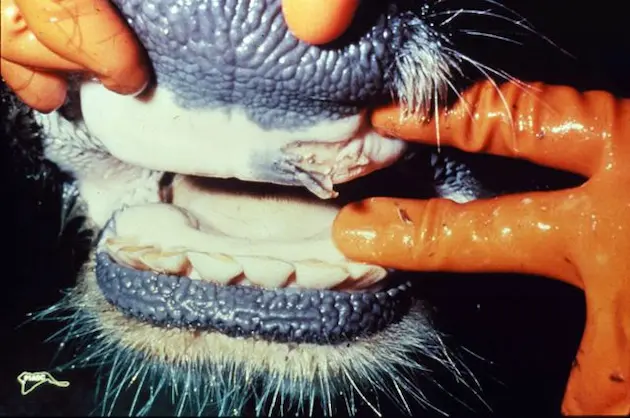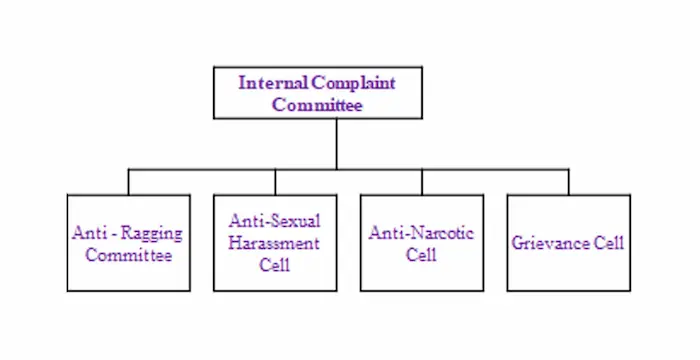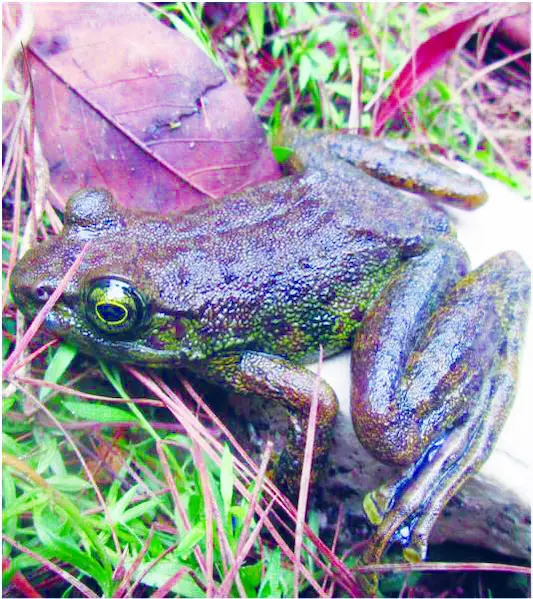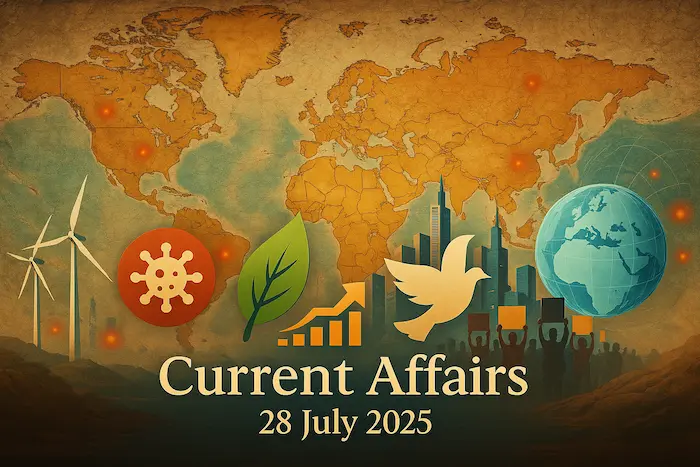1. Foot and Mouth Disease (FMD): A Livestock Health Concern Resurfaces – Science & Technology

Why in News?
The recent death of 16 spotted deer (chitals) at the Rajiv Gandhi Zoological Park in Pune has been confirmed to be due to Foot and Mouth Disease (FMD), highlighting the persistent threat this disease poses to animal populations, particularly livestock and wildlife.
What is Foot and Mouth Disease (FMD)?
Causative Agent:
- Caused by an aphthovirus from the family Picornaviridae
- Affects cloven-hoofed animals: cattle, pigs, sheep, goats, deer, etc.
Not to Be Confused With:
- Hand, Foot and Mouth Disease (HFMD) – A completely different illness affecting humans (especially children), caused by Coxsackievirus, and unrelated to FMD.
How is FMD Transmitted?
| Mode of Transmission | Examples |
|---|---|
| Direct Contact | Infected animals (saliva, nasal secretions, milk, semen) |
| Indirect Contact | Contaminated feed, water, equipment, clothing, vehicles |
| Airborne Spread | Virus particles carried by air (short to medium distances) |
| Mechanical Vectors | Humans, wildlife, and transport mechanisms (e.g., boots, tires) |
Symptoms in Animals
- High fever
- Blister-like lesions on tongue, lips, hooves, and teats
- Lameness and reluctance to move or eat
- Reduced milk production and poor weight gain
- Fatal in young animals due to cardiac complications
Prevention and Control Measures
Vaccination:
- Strain-specific vaccines are available
- There are 7 known strains of FMD virus – no cross-immunity
- Regular and mass vaccination programs are key to controlling outbreaks
Biosecurity Protocols:
- Disinfection of equipment and personnel
- Movement restrictions during outbreaks
- Culling in extreme cases (as a last resort)
Economic and Agricultural Impact
- Severe losses in:
- Milk and meat production
- Export restrictions due to loss of “FMD-free” status
- Affects rural livelihoods, especially smallholder farmers
- Hampers goals of improving animal productivity and rural income
India’s Response and Initiatives
- National Animal Disease Control Programme (NADCP) launched in 2019
- Aim: 100% vaccination coverage for FMD and brucellosis in livestock
- Budget: ₹13,000 crore for five years
- Objective: Achieve FMD-free India by 2030
Himachal Pradesh Context
- HP has a significant rural and agrarian economy, with cattle and sheep rearing a key livelihood in districts like Mandi, Chamba, and Kinnaur.
- Outbreaks of FMD can devastate local dairy cooperatives, wool production, and eco-tourism parks with wildlife.
- Strengthening veterinary surveillance, local vaccination drives, and public awareness is essential for hill-state resilience.
Exam Connect – Possible Questions
Prelims
- Foot and Mouth Disease (FMD) primarily affects which category of animals?
A. Birds
B. Amphibians
C. Cloven-hoofed mammals
D. Reptiles
Answer: C. Cloven-hoofed mammals - Which of the following diseases affects humans and is not related to Foot and Mouth Disease?
A. Anthrax
B. Brucellosis
C. Hand, Foot and Mouth Disease
D. Rabies
Answer: C. Hand, Foot and Mouth Disease - Which national program aims to eliminate Foot and Mouth Disease in India?
A. National Livestock Mission
B. Rashtriya Krishi Vikas Yojana
C. National Animal Disease Control Programme
D. Operation Flood
Answer: C. National Animal Disease Control Programme
Mains
- “Discuss the causes, transmission, and control measures of Foot and Mouth Disease (FMD). Evaluate its impact on rural livelihoods in India.”
- “Analyze the effectiveness of India’s National Animal Disease Control Programme in achieving disease-free livestock status. Suggest improvements in veterinary infrastructure.”
- “With livestock rearing being an important livelihood in Himachal Pradesh, what steps can the state government take to prevent outbreaks of diseases like FMD and brucellosis?
2. Internal Complaints Committees (ICCs): Addressing Gender Justice or Symbolic Compliance? – Polity

Why in News?
A tragic incident in Balasore, Odisha, where a student took her own life after her sexual harassment complaint was dismissed by her college’s Internal Complaints Committee (ICC), has reignited a national debate on the functionality, neutrality, and training of ICCs in educational institutions and workplaces.
Key Concerns Raised
- Bias and non-accountability of ICC members
- Lack of legal awareness and training
- Misuse or non-implementation of guidelines
- Breach of confidentiality protocols, further traumatizing victims
Legal Framework Behind ICCs
Vishaka Guidelines – 1997
- Issued by the Supreme Court in response to the Bhanwari Devi case
- Defined sexual harassment and established the first legal mandate for complaint committees at workplaces
- Required that committees be:
- Headed by a woman
- Include external NGO/activist members
- Have a majority of women members
POSH Act, 2013
Full Name: The Sexual Harassment of Women at Workplace (Prevention, Prohibition and Redressal) Act
- Enacted to codify and enforce the Vishaka guidelines
- Made it mandatory for all workplaces with more than 10 employees to set up ICCs
- Introduced Local Committees (LCs) at the district level for informal or smaller workplaces
Structure of an Internal Complaints Committee (ICC)
| Position | Requirement |
|---|---|
| Chairperson | Senior woman employee |
| Internal Members | At least 2 with experience in social/legal issues |
| External Member | From an NGO or legal background (must be independent) |
| Women Representation | At least 50% of members must be women |
Complaint and Inquiry Process under POSH Act
- Complaint Window: Within 3 months of the incident (extendable)
- Inquiry Period: ICC must complete inquiry within 90 days
- Confidentiality: Identities of the complainant, accused, and witnesses must be protected
- Action: Disciplinary recommendations made to the employer or institution’s authority
- Penalty for Non-Compliance: Fine up to ₹50,000 and cancellation of license for repeated violations
Issues in Implementation
- ICCs often exist only on paper
- Lack of trained members and regular orientation programs
- Victim-blaming attitude, lack of support mechanisms
- External members sometimes selected without proper vetting
- Reports of delay, mishandling, or outright dismissal of cases
- The Supreme Court in 2023 had warned that the implementation of the POSH Act is “far from satisfactory”, calling for urgent state and institutional audits
Himachal Pradesh Context
- Educational and professional institutions in HP (including universities and government offices) are mandated under the POSH Act to form ICCs.
- There is a growing need for sensitization and training, especially in rural and semi-urban institutions, to ensure safe and responsive grievance redressal mechanisms.
Exam Connect – Possible Questions
Prelims
- Which of the following is mandated by the POSH Act, 2013?
A. Setting up fast-track courts for sexual harassment cases
B. Establishment of Internal Complaints Committees in workplaces with 10+ employees
C. Creation of women-only police stations in every district
D. Mandatory psychological counselling for all complainants
Answer: B. Establishment of Internal Complaints Committees in workplaces with 10+ employee - Which landmark Supreme Court case laid the foundation for the Vishaka Guidelines?
A. Shah Bano v. Union of India
B. Vishaka v. State of Rajasthan
C. Olga Tellis v. Bombay Municipal Corporation
D. Keshavananda Bharati v. State of Kerala
Answer: B. Vishaka v. State of Rajasthan - Which of the following is not a mandatory member of an ICC as per POSH Act, 2013?
A. Senior woman employee as chairperson
B. A government-appointed judge
C. External member from NGO/legal background
D. At least 50% women representation
Answer: B. A government-appointed judge
Mains
- “The Internal Complaints Committees under the POSH Act were meant to serve as guardians of gender justice. Critically assess their effectiveness and suggest reforms for better implementation.”
- “Examine the role of judicial guidelines in shaping institutional accountability in India, with reference to the Vishaka Guidelines and the POSH Act.”
- “Ethical leadership and institutional sensitivity are essential for fair redressal of sexual harassment complaints. Discuss with reference to the functioning of ICCs.”
3. NISAR Satellite – A Landmark NASA–ISRO Collaboration for Earth Observation – Science & Technology

Why in News?
The Indian Space Research Organisation (ISRO) is preparing to launch the NISAR (NASA-ISRO Synthetic Aperture Radar) satellite on July 30, 2025, from Sriharikota aboard a GSLV Mk-II. Developed at a cost of ₹12,000 crore over more than a decade, NISAR is poised to become one of the world’s most advanced Earth observation satellites.
What is NISAR?
- A joint project between NASA (USA) and ISRO (India)
- First dual-frequency Synthetic Aperture Radar (SAR) satellite
- Aimed at continuous and high-resolution monitoring of Earth’s surface changes
Technical Features
| Radar Band | Managed By | Purpose |
|---|---|---|
| L-band (1.257 GHz) | NASA | Penetrates vegetation, snow, soil – detects subsurface movement and deep crustal changes |
| S-band (3.2 GHz) | ISRO | Surface-level changes – useful for tracking crop growth, biomass, urban expansion |
- Swath Width: 240 km
- Resolution: 3–10 meters
- Orbit Type: Sun-synchronous, polar orbit
- Coverage: Global (with India-specific enhancements)
Scientific and Practical Applications
- Disaster Management:
- Detects landslides, floods, earthquakes, and tsunamis
- Monitors glacial movement and coastal erosion
- Agriculture:
- Tracks crop biomass, growth cycles, and yield predictions
- Supports precision farming initiatives
- Climate Change Monitoring:
- Measures land subsidence, permafrost melting, ice sheet dynamics
- Forestry & Biodiversity:
- Detects deforestation and changes in carbon stocks
- Assists in wildlife habitat mapping
- Urban Planning:
- Monitors urban sprawl, infrastructure stress, and groundwater depletion
India-Specific Enhancements
- S-band data operations will be locally controlled by ISRO
- Enables:
- Real-time monitoring of Indian agriculture
- Early warning systems for natural disasters
- Support to programs like PM Fasal Bima Yojana and Digital India
Data Accessibility
- Open-data policy: Data will be publicly accessible within a few hours of acquisition
- Encourages global research collaboration and citizen science
Strategic & Technological Importance
- Enhances India’s space diplomacy through collaboration with the US
- Boosts capabilities in space-based remote sensing
- Bridges gap in continuous Earth observation, currently dominated by western agencies like ESA and NASA
- Builds synergy for future deep-space missions and planetary exploration
Himachal Pradesh Context
- Potential Applications in HP:
- Landslide mapping and forecasting in hilly terrain
- Monitoring glacial retreat in Lahaul-Spiti and Kinnaur
- Estimating forest biomass and improving carbon credit mechanisms
- Supporting disaster preparedness during floods and cloudbursts
Exam Connect – Possible Questions
Prelims
- Which of the following best describes the NISAR satellite?
A. A Mars orbiter jointly developed by ISRO and NASA
B. A geostationary satellite for telecom purposes
C. A dual-frequency radar Earth observation satellite
D. An Indian satellite focused only on crop insurance
Answer: C. A dual-frequency radar Earth observation satellite - Which of the following correctly matches the radar frequency and its function in NISAR?
A. S-band – Subsurface movement
B. L-band – Crop monitoring
C. L-band – Subsurface movement
D. Both bands are used solely for space weather monitoring
Answer: C. L-band – Subsurface movement - What is the resolution range of the NISAR satellite?
A. 100–500 meters
B. 3–10 meters
C. 50–100 kilometers
D. 0.5–1 meter
Answer: B. 3–10 meters
Mains
- “Discuss the significance of the NISAR mission for Earth observation and disaster management. How does it reflect the evolution of international collaboration in space research?”
- “Earth observation satellites are crucial tools in the fight against climate change. Evaluate the role of the NISAR satellite in addressing India’s environmental challenges.”
- “How can space-based technologies like NISAR be integrated into disaster management systems in Himalayan states like Himachal Pradesh?”
4. India–UK Free Trade Agreement (FTA): A New Era in Bilateral Economic Relations – International Relations

Why in News?
India and the United Kingdom have formally signed a Comprehensive Economic and Trade Agreement (CETA), finalizing a strategic deal that was under negotiation since January 2022. This landmark FTA aims to boost bilateral trade, promote services sector access, and expand investment opportunities, making it one of the most significant post-Brexit trade deals for the UK.
Key Trade Provisions of the India–UK FTA
Tariff Reductions
| For UK | For India |
|---|---|
| Eliminates 99% tariffs on product lines | Reduces duties on 90% of Indian tariff lines |
| Benefits 45% of India’s exports: textiles, footwear, auto components, seafood | Covers 92% of UK’s exports: whisky, cars, telecom, machinery |
Sectoral Highlights
Goods Trade
- UK gains: Luxury vehicles, whisky, industrial machinery, fresh fruits
- India gains: Pharmaceuticals, textiles, petroleum products, seafood
- Notably, India retains full control over sensitive agricultural sectors
Services Trade
- UK firms can now operate in accounting, legal, and telecom sectors without local offices
- Opens up opportunities for Indian IT professionals, though complete mobility liberalization remains pending
Automobile Duties
- India agrees to reduce duties on luxury vehicles (engine size >3000cc)
- Duties will fall from 110% to 10% over 15 years, under a quota-based system
Social Security: Double Contribution Convention (DCC)
- Allows 75,000 Indian professionals on short-term UK assignments to avoid double social security payments
- Eases cost of living and simplifies regulatory compliance for companies and workers
Government Procurement
- UK firms gain access to ~40,000 Indian public procurement contracts in transport and renewable energy
- India retains data localisation and public health safeguards
Economic Significance
- Bilateral trade set to cross $34–40 billion in the next 5 years
- Could increase UK GDP by £4.8 billion and India’s GDP by ~0.7%
- Enhances investment confidence and market access post-Brexit
- Signals India’s increasing engagement with Western democracies through trade diplomacy
Himachal Pradesh Context
- Potential for agricultural exports (e.g., organic apples, floriculture, honey)
- UK collaboration in renewable energy projects and smart mobility could benefit HP’s developmental plans
- Opportunity for startups and tourism-based services to attract UK investment and visitors
Exam Connect – Possible Questions
Prelims
- The India–UK Comprehensive Economic and Trade Agreement (CETA) allows:
A. Free movement of Indian labor without visa requirements
B. Tariff-free access to all agricultural products from the UK
C. Reduction of import duties on UK luxury cars to 10% over 15 years
D. Indian citizenship for UK investors
Answer: C. Reduction of import duties on UK luxury cars to 10% over 15 years - Under the Double Contribution Convention (DCC), Indian professionals on short-term UK assignments:
A. Must contribute to both UK and Indian pension systems
B. Are exempt from Indian taxes
C. Contribute only to India’s social security system
D. Need not pay any tax in the UK
Answer: C. Contribute only to India’s social security system - Which of the following sectors is NOT a key focus under the India–UK CETA agreement?
A. Textiles
B. Renewable Energy
C. Fisheries
D. Defence Procurement
Answer: D. Defence Procurement
Mains
- “The India–UK Free Trade Agreement is more than just a trade pact—it is a strategic partnership. Discuss the political, economic, and diplomatic significance of this agreement.”
- “Analyze how bilateral FTAs such as the one between India and the UK can support the Indian diaspora, particularly in terms of labor mobility and social security.”
- “Evaluate the impact of India’s growing bilateral FTAs on its domestic manufacturing and services sectors. What should be the safeguards to protect local industries?”
5. India’s Insurance Sector: Projected Boom and Structural Shifts by 2030 – Economy
Why in News?
A joint report by the Insurance Brokers Association of India (IBAI) and McKinsey & Company, validated through the IBAI Insurance Insights Survey, projects a 123% surge in India’s Gross Written Premiums (GWP) by 2030. This reflects massive transformation across retail and institutional insurance segments, driven by rising awareness, economic expansion, and digital access.
Key Projections
| Indicator | 2024 | 2030 (Projected) |
|---|---|---|
| Gross Written Premiums (GWP) | ₹11.2 lakh crore | ₹25 lakh crore |
| Insurance Penetration (% of GDP) | 3.7% | 5% (approaching global avg of 6.8%) |
| Retail Segment GWP | ₹8.4 lakh crore (approx.) | ₹21 lakh crore |
| Institutional Segment GWP | ₹93,000 crore | ₹2.8 lakh crore |
Key Concepts
Gross Written Premiums (GWP):
- Refers to the total insurance premiums collected before accounting for claims, commissions, or reinsurance.
- Serves as a primary indicator of insurance market size and growth.
Insurance Penetration:
- Defined as total premium as a % of GDP
- Reflects the extent of insurance inclusion in the economy
- India’s current rate (3.7%) is below the global average (6.8%) — indicating vast untapped potential.
Retail Segment Dynamics
- Life insurance dominates, especially among salaried classes and HNI/UHNI clients, who account for 65% of market opportunity.
- Growing awareness of term insurance, health plans, and digital platforms like online aggregators.
- Young demographics and increasing financial literacy will continue to drive demand.
Institutional Segment Dynamics
- Non-life insurance to lead, particularly health, cyber, property, and marine insurance.
- SMEs (Small and Medium Enterprises) represent high-growth potential due to currently low coverage.
- Institutional GWP to triple by 2030, driven by:
- Digitisation of business
- Mandates for liability and employee benefit coverage
- Public-private schemes for MSMEs
Structural Trends and Challenges
Opportunities:
- Emergence of InsurTech platforms (AI-driven claim management, predictive underwriting)
- Scope for product innovation (micro-insurance, bundled coverage)
- Financial inclusion via PM Suraksha Bima Yojana, Jan Suraksha schemes
Challenges:
- Low rural penetration and insurance literacy
- Cumbersome claims processes, especially in health and crop insurance
- Need for robust regulatory oversight by IRDAI
- Balancing innovation with consumer protection
Himachal Pradesh Context
- Potential to improve insurance coverage in agriculture (crop/weather insurance) and tourism-related businesses
- Micro-insurance models for small traders, artisans, and horticulturists
- Scope for integrating insurance literacy into rural development and self-help group programs
Exam Connect – Possible Questions
Prelims
- What does Gross Written Premium (GWP) refer to in the insurance sector?
A. Profit generated after taxes
B. Total policies rejected in a year
C. Total premium collected before deductions
D. Claims settled in a year
Answer: C. Total premium collected before deductions - Which of the following statements is correct regarding insurance penetration in India?
A. It currently exceeds the global average
B. It refers to the number of insurance agents per capita
C. It is expected to rise from 3.7% in 2024 to 5% by 2030
D. It is measured in terms of claims settlement ratio
Answer: C. It is expected to rise from 3.7% in 2024 to 5% by 2030 - Which of the following segments is projected to drive the growth of institutional insurance in India?
A. High-net-worth individuals
B. Banking sector
C. Startups in metro cities
D. Small and Medium Enterprises (SMEs)
Answer: D. Small and Medium Enterprises (SMEs)
Mains
- “Discuss the factors driving the projected boom in India’s insurance sector by 2030. How can regulatory and technological innovations support this growth?”
- “Despite targeted government schemes, insurance penetration in rural India remains low. Identify the key challenges and suggest reforms for inclusive insurance coverage.”
- “Analyze the potential of micro-insurance and crop insurance in promoting livelihood security in Himachal Pradesh. What steps can the state take to improve coverage and awareness?”
6. Discovery of New Bush Frogs in Meghalaya: Boost to India’s Biodiversity – Environment

Why in News?
Two new species of bush frogs — Raorchestes jadoh and Raorchestes jakoid — have been discovered in Meghalaya, highlighting the ecological richness of the Eastern Himalayan biodiversity hotspot and emphasizing the need for continued conservation research.
Key Highlights of the Discovery
| Species Name | Location Found | Elevation |
|---|---|---|
| Raorchestes jadoh | Langtor, Eastern West Khasi Hills | 1,655 m ASL |
| Raorchestes jakoid | Lawbah, East Khasi Hills | 815 m ASL |
- Belong to the Raorchestes genus, which now includes 80 recognized species.
- Exhibit direct development – i.e., no tadpole stage, the froglets emerge fully formed from eggs.
Habitat and Adaptability
- Inhabit bushes and trees in proximity to human settlements, indicating ecological resilience and adaptability.
- Thrive in semi-disturbed ecosystems, making them indicators of habitat quality.
Evolutionary and Scientific Significance
- Identified using distinct calls, morphological traits, and DNA barcoding.
- Part of the Raorchestes parvulus species complex, suggesting they have evolved unique adaptations over time.
Geographical Range of the Genus
- Spread across:
- Southern and Northeastern India
- Nepal, Myanmar, Thailand, Laos, Cambodia, Vietnam
- Southern China and Malaysia
The discovery enhances understanding of biogeographical linkages between the Indian subcontinent and Southeast Asia.
Conservation Significance
- Meghalaya is part of the Indo-Burma biodiversity hotspot, known for high endemism.
- Amphibians are highly sensitive to environmental changes, making them key bioindicators.
- Threats to bush frogs include:
- Habitat destruction
- Urban expansion
- Climate change
- Agrochemical use
Himachal Pradesh Context
- HP, like Meghalaya, is part of the Himalayan biodiversity region and hosts endemic amphibian species (e.g., Nanorana minica and Scutiger sikimmensis).
- Highlights the importance of ecological surveys, herpetological research, and community-based conservation in HP’s fragile mountain ecosystems.
Exam Connect – Possible Questions
Prelims
- Raorchestes jadoh and Raorchestes jakoid recently discovered in Meghalaya are:
A. Aquatic snakes
B. Lichen species
C. Bush frog species
D. Invasive fish species
Answer: C. Bush frog species - What unique biological trait do frogs of the Raorchestes genus exhibit?
A. Viviparity
B. Direct development without a tadpole stage
C. No vocal sac
D. Only nocturnal feeding
Answer: B. Direct development without a tadpole stage - Which of the following is a biodiversity hotspot that includes Meghalaya?
A. Western Ghats
B. Indo-Burma
C. Eastern Himalayan Plateau
D. Deccan Plateau
Answer: B. Indo-Burma
Mains
- “Discuss the significance of the discovery of new species like Raorchestes jadoh and Raorchestes jakoid in understanding biodiversity in the Indian subcontinent.”
- “How do amphibians act as indicators of ecosystem health? Evaluate their role in biodiversity conservation with examples from Himalayan and Northeastern regions.”
- “With Himachal Pradesh being rich in endemic species, what measures should be taken to promote biodiversity documentation and conservation at the state level?”
7. United Nations Office on Drugs and Crime (UNODC): Global Watchdog Against Illicit Drugs and Crime – International Relations

Why in News?
A joint report by the World Health Organization (WHO) and the United Nations Office on Drugs and Crime (UNODC) highlighted that over 1,300 deaths over the past 90 years were caused by contaminated medicines, renewing global attention on pharmaceutical safety and the role of UNODC in drug regulation, crime prevention, and terrorism control.
About UNODC
- Established: 1997
- Formed by merging:
- United Nations Drug Control Programme
- Centre for International Crime Prevention
- Headquarters: Vienna, Austria
- Funding: Primarily through voluntary contributions from UN member states
Mandate and Key Functions
| Area | UNODC Role |
|---|---|
| Illicit Drug Control | Monitors global drug trends; supports alternative development to reduce drug cultivation |
| Crime Prevention | Assists countries in criminal justice reform and capacity building |
| Transnational Organized Crime | Supports anti-trafficking, anti-smuggling, and anti-corruption programs |
| Counter-Terrorism | Terrorism Prevention Branch (2002) helps countries implement UN conventions on terrorism |
| Anti-Corruption | Works with signatories to the UN Convention against Corruption (UNCAC) |
| Pharmaceutical & Medicine Safety | Partners with WHO to address counterfeit and substandard medicines |
| Public Awareness | Educates youth and communities about drug abuse and organized crime dangers |
Recent Concern: Contaminated Medicines
- WHO–UNODC report points to 1,300 deaths linked to unsafe, substandard, or fake medicines over 90 years.
- Underscores global vulnerabilities in pharmaceutical regulation and supply chain monitoring, especially in low-income countries.
India and UNODC
- India is an active member of the UNODC and collaborates on:
- Anti-narcotics enforcement
- Cybercrime surveillance
- Human trafficking prevention
- Implementation of drug de-addiction and rehabilitation programs
Himachal Pradesh Context
- Himachal Pradesh has seen a rise in illegal cannabis cultivation and drug trafficking in certain border districts.
- Collaboration with national and international agencies like UNODC and Narcotics Control Bureau (NCB) is crucial for:
- Drug prevention education
- Strengthening local law enforcement
- Promoting alternative livelihoods in vulnerable communities
Exam Connect – Possible Questions
Prelims
- Where is the headquarters of the United Nations Office on Drugs and Crime (UNODC) located?
A. Geneva, Switzerland
B. New York, USA
C. Vienna, Austria
D. Nairobi, Kenya
Answer: C. Vienna, Austria - The UNODC was created in 1997 by merging which two entities?
A. WHO and UNHCR
B. UN Drug Control Programme and Centre for International Crime Prevention
C. IMF and World Bank
D. UNDP and UNICEF
Answer: B. UN Drug Control Programme and Centre for International Crime Prevention - Which of the following is not a key focus area of the UNODC?
A. Human trafficking
B. Cybercrime
C. Intellectual property law
D. Counter-terrorism
Answer: C. Intellectual property law
Mains
- “Discuss the role of multilateral organizations such as the UNODC in addressing the global challenges of drug abuse, organized crime, and terrorism.”
- “Evaluate India’s engagement with the United Nations Office on Drugs and Crime (UNODC) in tackling transnational threats such as narcotics trafficking and terrorism financing.”
- “With rising drug-related challenges in Himalayan states, how can Himachal Pradesh leverage international collaboration and preventive education to curb narcotics abuse and trafficking?”

